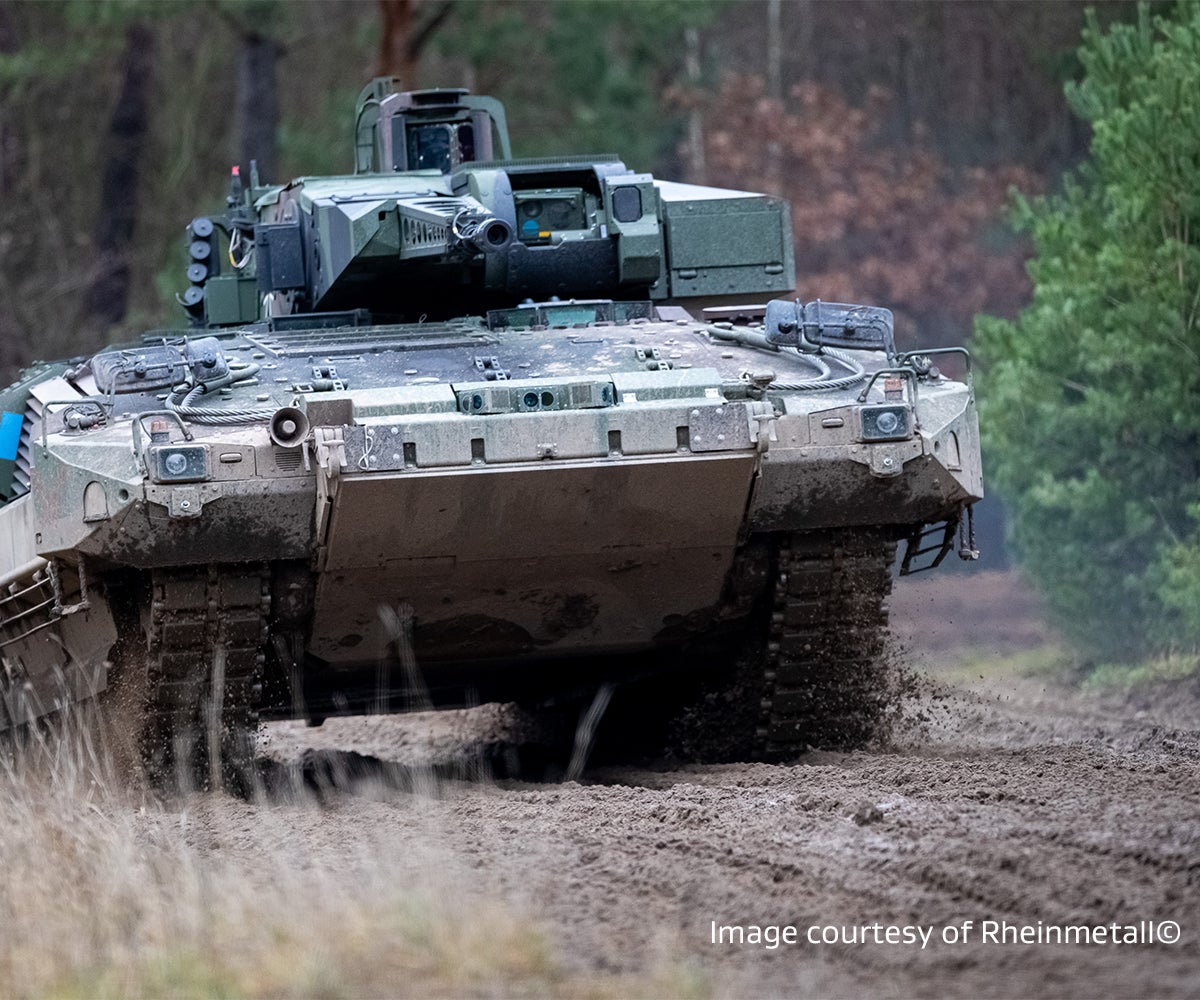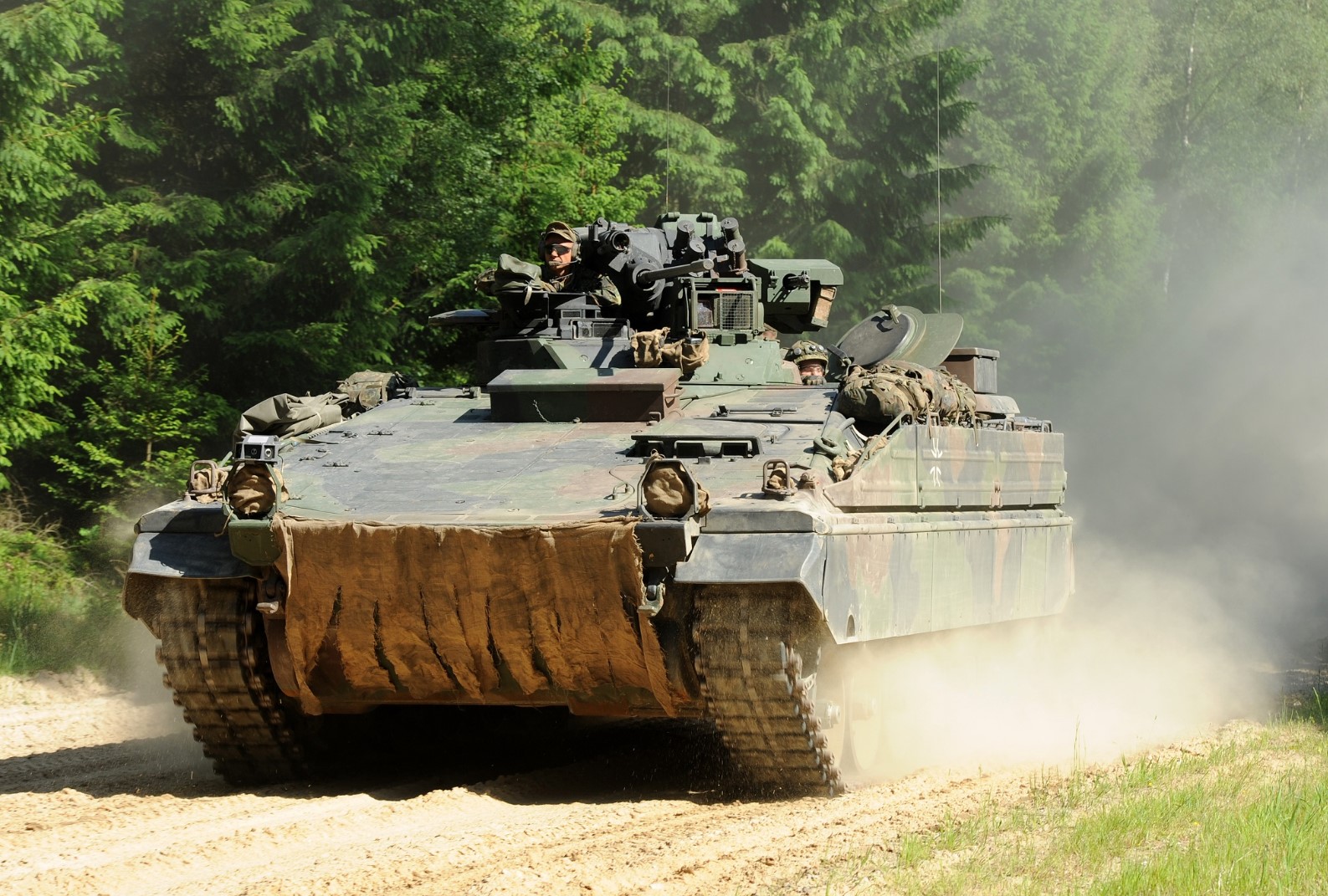German Puma Ifv - The Puma Browning Infantry Fighting Vehicle (AIFV) is a tracked vehicle developed by Project Systems and Management (PSM), a joint venture between German defense company Rheinmetall Landsysteme and Krauss-Maffei Wegmann (KMW). 2002 German Federal Parliament.
In December 2004, the German Bundestag approved the initial production of the first five cars. The first prototype vehicles and system indicators were launched in December 2005 and delivered in May 2006. Started in early 2008. In March 2009, the first two Puma vehicles successfully completed trials and testing at the German Army Training Center.
German Puma Ifv

In June 2009, the German parliament approved the purchase of 405 vehicles, and in July 2009, PSM won a €3 billion contract. The first series production Puma entered service in 2010. The Puma vehicles replace the Rheinmetall Landsysteme Marder 1 infantry fighting vehicle. It entered service with the German Army in 1971 and soon reached the end of its operational life.
German Puma Ifv Will Be Introduced Into Service In April
The development program included the production and testing of several key Puma subsystem demonstrators evaluating armor protection, weapons and ammunition handling and flow systems, three versions of the turret and three versions of the chassis.
In March 2012, the IFV demonstrated its ability to operate in arctic conditions with temperatures below -30°C on perfect ground in the Arctic in Norway.
The Puma entered service with the German armed forces in April 2015 after undergoing rigorous testing and completing final acceptance tests.
PSM was awarded four contracts worth £370 million ($422.5 million) by the German Federal Bundeswehr Office for Equipment, Information Technology and Service Support (BAAINBw) in July 2017 to modernize the Puma AIFV.
Germany's Impending Puma Panzer Problem
The contracts included the installation of advanced sighting and display technology, development of the new Torus Independent Weapon System (TSWA), logistics and training for the Multipurpose Self-Defense System (MUSS), and the provision of an additional 11 Tortura trainers. An update of the existing.
In July 2019, a contract was signed between the Rheinmetall-KMW consortium and the German Bundeswehr to upgrade the Puma AIFV under the "System Panzergrenadier VJTF 2023" project. The system integrates the Panzegrenadier (Brunick Infantry) VJTF 2023 series Puma vehicle with the German Army's Future Soldier-Extended System (IdZ-ES) troop system in a cyber-warfare environment.
PSM signed a contract worth more than one billion euros ($1.19 billion) with the German Bundeswehr to put 154 Puma AIFVs into service in June 2021. It also provides logistics services and further increases efficiency. These machines will be updated in terms of core functionality by replacing the tested equipment with 40 Puma test machines. The 40 Puma AIFVs tested will be deployed to NATO's Very High Readiness Joint Task Force (VJTF) Rapid Response Force from 2023.

Hall is not a derivative of the old system, but a new design. Rheinmetall is responsible for the construction and design of the chassis. The vehicle is equipped with a crew of three (commander, gunner and driver) and has eight types of equipment in the rear compartment.
Puma Ifv Spz
The vehicle is of modular construction and can be fully flown on the A400M aircraft.
The vehicle was armed with a Kraus-Maffei Wegmann-developed remote-controlled weapon station with a double-feed Mauser 30 MK 30-2 cannon. Rheinmetall is responsible for the integration of Mauser cannons and ammunition handling systems. The MK 30-2, which is being produced for the Spanish Pizarro and Austrian Ulan IFVs, has 700 rounds per minute and a range of up to 3 km.
The cannon is a 30mm APFSDS-T (Armor-Piercing Stabilized Drop-Tracker) round with a firing velocity of 1,385m/s.
Developed by RWM Schweiz AG (formerly Oerlikon Contraves Pyrotec) and qualified in Switzerland for deployment to the Swiss and Austrian armed forces, this round has entered production. The round table has no built-in uranium penetration and is non-toxic.
Amazon.com: Rye Field Model Rfm5021 Model Building German Shooting Tank Puma Multi Coloured
The MK 30-2 cannon also fires FAPIDS-T (Frangible Armor-Piercing Incendiary Sabot-Tracer) rounds deployed against hard and soft targets.
RWM Schweiz AG's new round of 30mm air-blasted ammunition (ABM) is undergoing qualification testing with the German military at Puma.
The ABM round (length 173 mm, diameter 30 mm) consists of an electronic timer, an ejection charge and a 135 cylindrical barrel alloy rod or cannon. The electronic timer is programmed by induction coupling using a device mounted on the muzzle of the cannon. The timer releases and disperses the Tungsten projectiles before they impact the target.

Eurospike will supply the Spike-LR anti-fire and anti-tank missile to meet the German Army's need for a guided missile system to arm the Puma Braunschweig vehicle. In December 2008, an agreement was signed between PSM and the German Ministry of Defense to integrate the Spuma missile system into Puma vehicles.
Revell Modern German Army Spz Puma Ifv
There is a fire extinguisher system in the crew compartment and a fire extinguisher system in the engine compartment.
The Puma AIFV has a combined Nuclear, Biological and Chemical (NBC) defense system and AC sensors to detect imminent attacks.
The vehicle is equipped with a new high power density 892 series diesel engine developed by MTU. The MTU 892 series is rated at 800kW, and Puma's power rating is 25.4kW/t.
The running gear is decoupled, so the car has low noise and vibration characteristics. Krauss Maffei Wegmann is responsible for the car's hydropneumatic suspension system. Diehl was chosen to provide this path.
Puma Infantry Fighting Vehicle
In April 2008, the German Defense Procurement Office awarded PSM the contract to integrate the battlefield management system into Puma. System integration brings network-enabled features to the machine.
The vehicle is designed with three levels of safety options to suit operational requirements. Versions weigh 29.4t, 31.45t and 43t.
The base 1-, 29.4t, version of the Explosive Bomb (EFP) provides protection against mines, maximum offensive artillery and 14.5 mm kinetic energy rounds and RPG-7 rocket propelled grenades.

The front and sides of the car are equipped with a high level of protection against 30 mm of kinetic energy circles.
The German Military Faced Massive Failures Of The Puma Ifv Systems
The A-Class Puma IFV was chosen as the main weapon protection of the German Army.
Tier A provides all-round protection against 14.5 mm machine gun and artillery pieces. The front and sides are protected by 30 mm cannon. Frontal armor protects the crew from hollow charges. The vehicle is also protected against 10kg blast and EFP mines. The German Army Puma A weighs 31.45t and is carried by A400M aircraft.
Additional armor modules are installed in the hull and turret to provide Class C protection. Combat weight increased to 43t with C-class armor protection. A class four A400M carrier will be deployed to carry three Puma infantry fighting vehicles capable of C-class armor protection, with a fourth aircraft fitted with additional modular armor. The Puma is a German infantry fighting vehicle (IFV) (Schützpanzer or SPz for short). Designed to replace the old Army Marder IFVs with the German Army. Production of the first batch of 350 vehicles began in 2010 and will be completed in August 2021. A second batch of 229 Pumas were funded.
The companies responsible for the project are Krauss-Maffei Wegmann and Rheinmetall Landsysteme, who jointly founded Projekt System Managemt GmbH (PSM). The Puma is one of the safest IFVs in the world, while still having a strong power-to-weight ratio.
Development] Puma: A 'muss' Have
Started as a follow-up project to the German "NGP" project in 1996 (Neue Gepanzerte Plattform, "New Armored Platform"). Its purpose was to gather ideas for a common base that could be used in multiple missions, such as replacing APCs, IFVs, air defenses and MBTs and supporting them in front-line roles. The NGP project was completed in 2001.
Lessons learned were incorporated into a new tactical concept known as the neuer Schützpanzer ("new IFV") in 1998. Puma's plan to succeed Marder began in 2002.
In the same year, the German Army (German Army) ordered the delivery of five pre-production vehicles and their logistics and training services in 2004 d. On November 8, 2007, a €3 billion budget was agreed for the purchase of 405 Pumas (not including the five Pumas delivered to the German Army for testing).

On December 6, 2010, the first two vehicles were delivered to the German Bundesamt für Wehrtechnik und Beschaffung.
Berlin To Supply Arms To Greece, Athens To Deliver Soviet Weapons To Kyiv Scholz
Puma successfully completed a cold trial in Norway in 2012. In August 2013, two Pumas were sent to the United Arab Emirates for weather testing. Tests include hot weather operations, desert firing and driving exercises, as well as firepower and maneuverability evaluations. During the test, the temperature profile inside the vehicle was measured relative to the ambient temperature.
On 13 April 2015, the Bundeswehr Equipmt, Federal Office for Information Technology and Support Services (BAAINBw) granted access.
Ifv puma, ifv cost, puma german army trainers, german ifv, ifv, ifv medical, ifv treatment, boxer ifv, puma german knives, puma german, ifv player, puma ifv cost
0 Comments